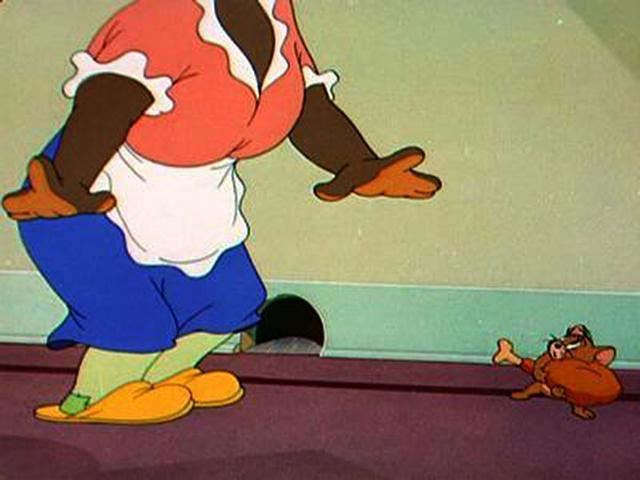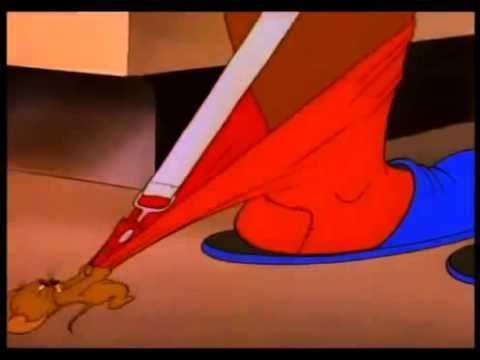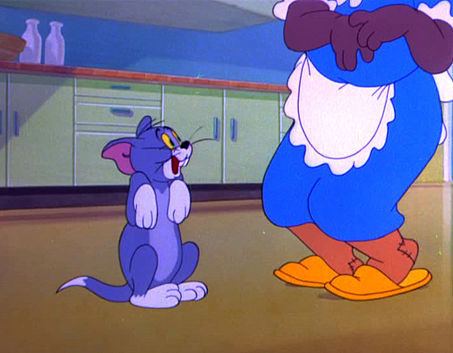Family Tom (pet) Last appearance Push-Button Kitty | Played by Nicole Oliver | |
 | ||
First appearance Puss Gets the BootFebruary 10, 1940 Created by William HannaJoseph Barbera Voiced by Lillian Randolph (1940–1952)June Foray (redubbed shorts, 1965–1966)Thea Vidale (redubbed shorts, 1989–1992)Nicole Oliver (Tom and Jerry Tales, 2006–2008)Monique Thierry (French)Leyla Horne (Spanish)Etsuko Kato (Japanese) Relatives Aunt Harriet (mentioned, not heard or seen in The Million Dollar Cat). Similar Tom, Nibbles, Toodles Galore, Tyke, Butch Cat | ||
Mammy Two Shoes (also referred to as Mrs. Two Shoes) is a fictional character in MGM's Tom and Jerry cartoons. She is a heavy-set middle-aged black housemaid who takes care of the house in which Tom and Jerry reside. She is also Tom's owner, and wallops the cat with a broom when he misbehaves; Jerry often tries to sabotage a task Mammy has given Tom or destroy the house and/or its contents, in order to get Tom thrown out of the house.
Contents

As a partially-seen character, she was famous for never showing her head, with a few exceptions such as Part Time Pal, A Mouse in the House, Mouse Cleaning, and Saturday Evening Puss.
Mammy would appear in many cartoons until 1952's Push-Button Kitty. Later cartoons would instead show Tom and Jerry living with a 1950s Yuppie-style couple. Soon after, virtually all humans in the series had visible faces. Mammy's appearances have often been edited out, dubbed, or re-animated as a thin white woman in later television showings, since her character is an archetype now often regarded as racist. Her creation points to the ubiquitousness of the mammy in American popular culture.

Theatrical Tom and Jerry cartoons

Mammy's debut appearances was in Puss Gets the Boot (1940), while her last appearance was in Push-Button Kitty (1952). She was originally voiced by well-known African-American character actress Lillian Randolph. She was the second prominent black character of the Metro-Goldwyn-Mayer cartoon studio, following Bosko. She appeared in 17 Tom and Jerry animated shorts between 1940 and 1952.

Mammy's role in the films was to set up the plot by warning her house cat Tom that she will toss him out of the house if he failed to act according to her wishes. She invariably catches Tom acting against her orders, and there are grave consequences for his disobedience. Naturally, it is Jerry that sabotages Tom to get him in trouble and even thrown out of the house at times. She always called Tom by his full name Thomas, and almost always used is in place of are and am ("is you" and "I is"). Her signature quotes are "Land Sakes!" and "What in the world is going on in here?", the latter of which is usually delivered upon rushing in to investigate the commotion being caused by Tom and Jerry.
William Hanna and Joseph Barbera initially portrayed Mammy as the maid of the house, with the real owners unknown to audiences. Or at least her apron suggests she is a maid. Later, Hanna and Barbera seemed to suggest, through dialogue and occasional behavior, that the house was Mammy's own. In one occasion, she goes to her bedroom. This suggests she owns the house and is its sole human occupant.
In the 1960s, the MGM animation studio, by then under the supervision of Chuck Jones, created censored versions of the Tom & Jerry cartoons featuring Mammy for television. These versions used rotoscoping techniques to replace Mammy on-screen with a similarly stocky white woman (in most shorts) or a thin white woman (in Saturday Evening Puss); Randolph's voice on the soundtracks was replaced by an Irish-accented (or, in Puss, generic young adult) voice performed by actress June Foray. Paul Mular, head of Broadcast Standards and Practices (BS&P) at KOFY-TV (Channel 20) in San Francisco in the late 1990s, believes this was an overreaction to calls for racial sensitivity as the original Mammy was inoffensive.
The original versions of the cartoons were reinstated when Turner Broadcasting System acquired ownership of the Tom & Jerry property on August 4, 1986. But in 1992, the cartoons featuring Mammy were edited again; this time, to replace Lillian Randolph's voice with that of Thea Vidale, who re-recorded the dialogue to remove Mammy's use of potentially offensive dialect. These re-recorded versions of the cartoons are aired to this day on Turner's Cartoon Network-related cable channels, and have at times turned up on DVD as well. However, some European TV showings of these cartoons, especially the UK, as well as the US DVD and Blu-ray release of Tom and Jerry Golden Collection, retain Randolph's original voice. The Region 2 Complete Collectors Edition DVD boxset has Vidale's voice on the first DVD and Randolph in a number of the episodes after that (such as A Mouse in the House and Mouse Cleaning).
Replacement characters for Mammy
In 1954's Pet Peeve, Mammy disappeared from Tom and Jerry; the owners of the animals' house became a young, white middle-class couple named Joan and George and starting with 1955's The Flying Sorceress, the audience was able to see these owners' faces.
In 1961, Rembrandt Films assumed production of the Tom and Jerry shorts. Director Gene Deitch opted not to use Mammy's character in his shorts, as he felt a "stereotypical black housekeep" character "didn't work in a modern context." In 1961's Down and Outing, Tom's owner became Clint Clobber, a corpulent white man who was more graphically brutal in punishing his pet's mistakes when compared to Mammy, often beating and thrashing Tom whilst going red in the face.
In the shorts Buddies Thicker Than Water (1962) and The Unshrinkable Jerry Mouse (1964), a slim white lady of the house appeared in place of Mammy. A similar character also appeared in the direct-to-DVD film Tom and Jerry: The Fast and the Furry (2005).
In the animated series "Tom and Jerry Tales" (2006–08), the character traditionally known as Mammy was reintroduced with a redesign, being referred to as "Mrs. Two-Shoes." While her personality remained largely consistent with previous portrayals, a significant change was made to her skin color, which was altered to white. This modification was presumably implemented to circumvent potential controversy. Several photos on a mantel in "Ho, Ho Horrors" also imply that Mammy now has a family (a man and a boy, also shown only as legs and partial torsos).
